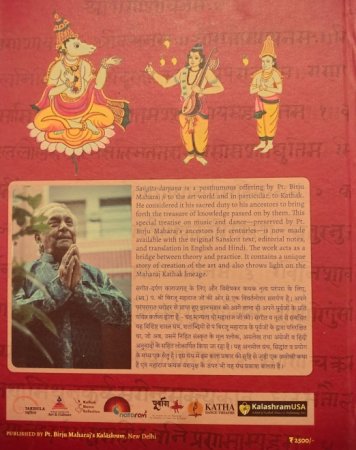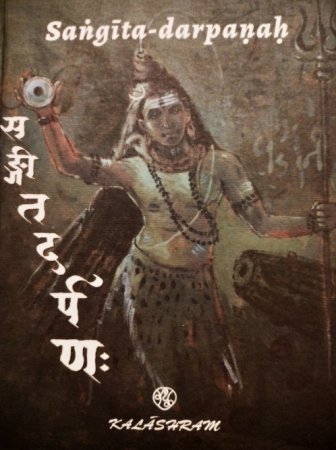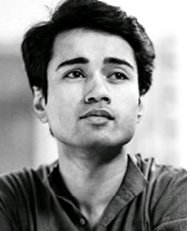
|   |

|   |
Pt. Birju Maharaj's ancestral treatise comes to life - Madhur Gupta e-mail: madhurgupta04@gmail.com December 5, 2022 It has been a profound fortune of our generation to have seen a master like (late) Pt. Birju Maharaj live in action in our lifetimes. To comprehend the emotion that he has passed on to the sattvic loka where he now rejoices with the gandharvas, ever mellifluous, ever sinuous, is tough to grasp for mortals like us. More so because the extensive length and breadth of work that he left in his sagacious lifetime, will let his memory never fade for generations to come. November month was the formal launch of Pothy - Gauriswara Sangeet Darpanah, an ancient treatise of Maharaj ji's great ancestors. Generous to a fault, when Maharaj ji received the Tagore fellowship by Sangeet Natak Akademi, he envisioned that this piece of literature on sangeet (gayan | vadan | nritya) should be shared with the janmanas and not kept bound to his family itself. Thus began the herculean task of translating manuscripts that were not only cryptic but also dense in their renditions. Initially taken over by senior disciple Kalpana Varma, the task very many years later came onto the shoulders of Sanskrit scholar Arjun Bharadwaj. With absolute support from his kalyan-shishya Saswati Sen and scholar/dancer Sunil Sunkara, the wheels of translations, transliterations, and transmissions began. As told to Bharadwaj, the Maharaj family had been preserving the Pothy (manuscript) for 10 generations. Akin to the Bhagavad Gita, the Maharaj family revered the Pothy as holy scriptures. The work now titled Gauriswara Sangeet Darpanah seems to be a scholarly colloquial reflection of the pan-Indian mahaveda on sangeet Natyashastra in the Awadh region. As per the scholars, on closer examination of the language, script, metric spacing, and the content of the text; it has been discerned that the Pothy was composed at least 400 years ago.   With 1172 verses, it is a unique treatise in which the metrical pattern itself has an inherent musicality to them. Written during the lifetime of Pt. Durga Prasad, ancestor of Pt. Birju Maharaj, the treatise is divided into three main sections. There is the katha of a gandharva Tomara who conveyed the vidya of sangeet and nritya; then there is a section on music and a very exhaustive one on dance. During the seminar, demonstrated by Shovana Narayan, several aspects of Sangeet Darpanah are categorically practiced in present day Kathak today. That said, with the meticulous and comprehensive bhedas (griva, hasta, kati, and so forth), the text becomes relevant to all present 'classical' dance styles. Speaking from personal experience, as an Odissi dancer, I could relate to the text explained and reflect on how the vaksha sanchalan (torso movement) mentioned in the treatise is so intrinsic to the lyricism of Odissi we practice in contemporary times. Understandably, there are equal amounts of vidhis and movement patterns that have gone out of vogue. But the text validates the antiquity of several 'neo-classical' dance practices revived during the Indian identification movement. From rasas to natyasutras, nayika bhedas, the content of Sangeet Darpanah releases itself of being bound to Kathak and adorns universality. Echoed by several luminaries present during the seminar the likes of Gurus Sonal Mansingh, Sharon Lowen, Pt. Sajan Mishra and several others, the generosity with which Maharaj ji shared his ancestral treasure with the world to do the madhupaan (imbibe nectar) is unheard, unseen, and truly inspirational. As a student of another dance style, I see immense value addition in reflecting upon this text and feel that my contemporaries too will take the opportunity to read, if not with a scholarly bent but with an artistic bent of the philosophical paragon that Sangeet Darpanah is. Maharaj ji always encouraged and blessed us in his physical form and we hope to continue seeking his blessings through his sukshma (astral) shareer for now and forever. To get a copy, please visit/contact- birjumaharaj-kalashram.com  Madhur Gupta is a leading Odissi dance exponent of his generation, a writer and columnist widely featured in national and international publications for his sensitive writings in the field of arts and culture. Madhur also teaches Odissi at Sangeet Vidya Niketan, New Delhi. |